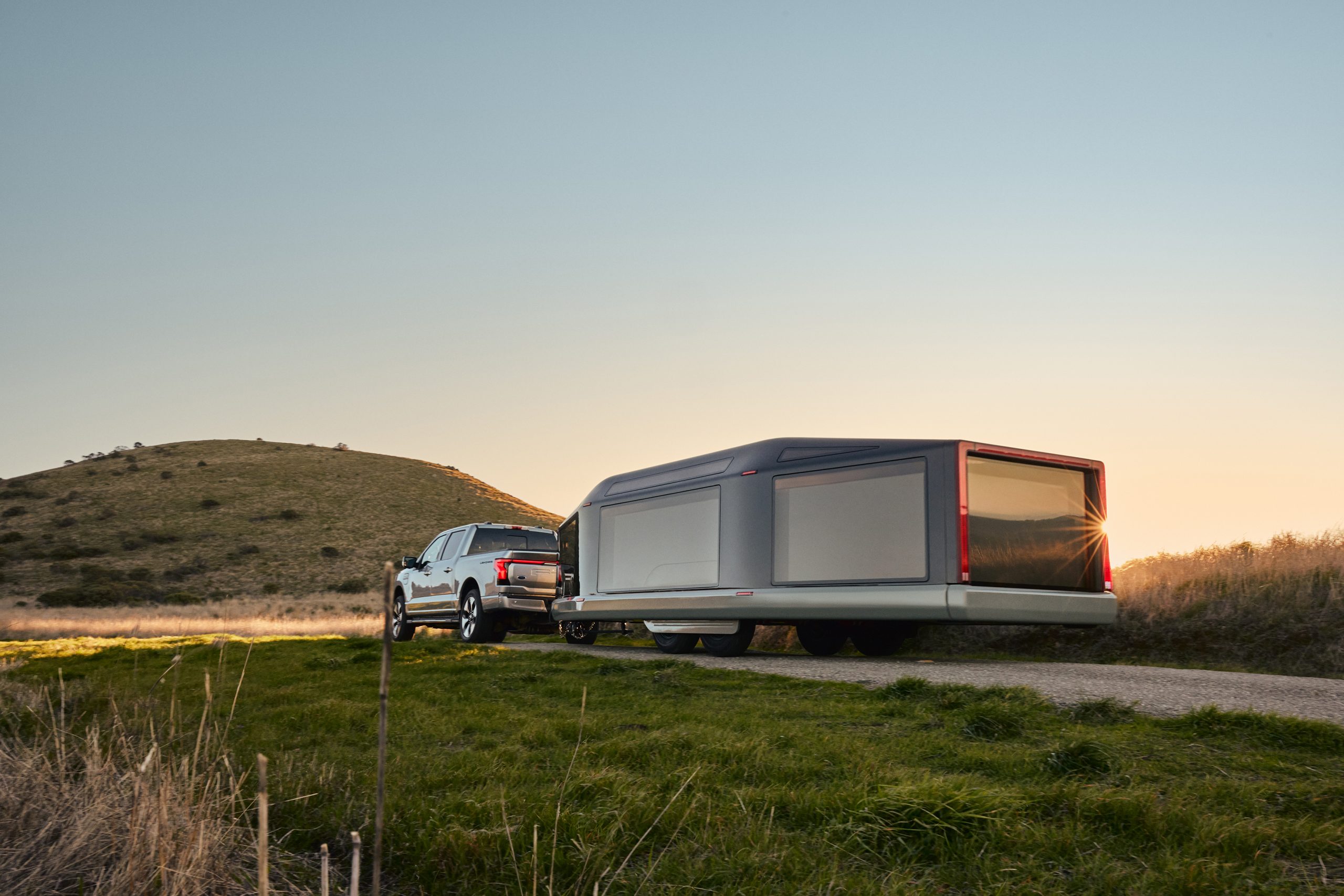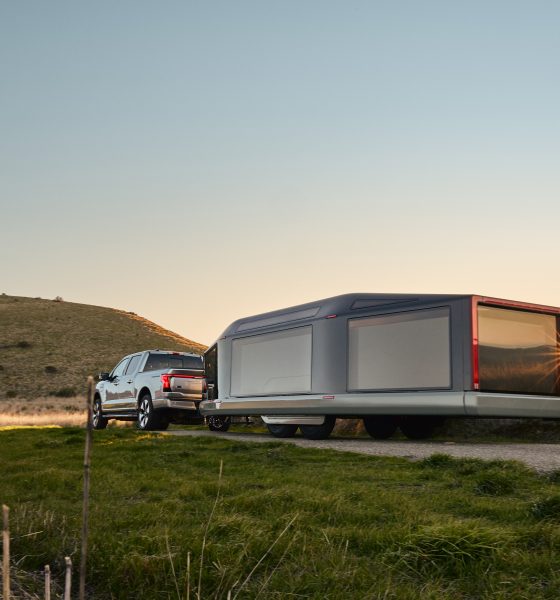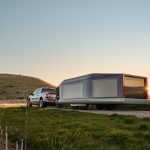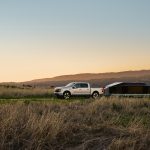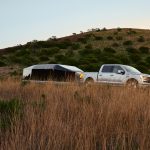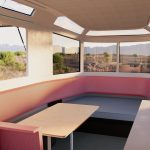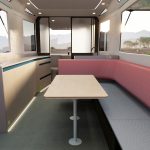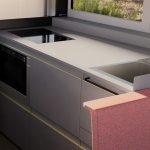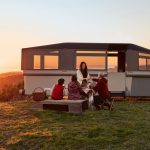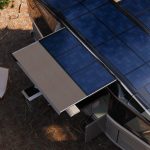A startup called Lightship is modernizing RVs into the 21st Century, as the industry has long been stagnated by a lack of advancement in not only technology but design. The company’s founders, who both started their careers at Tesla, have brought a new mentality to the RV sector that is geared toward sustainability, efficiency, and modernization.
Ben Parker and Toby Kraus believed RVs needed to be revolutionized by pushing them in the direction of what the automotive industry is: forward and with a mentality of sustainability.
Parker said that during his days at Tesla, he was confused as to why the line of food trucks at the company’s then-headquarters in Palo Alto was positioned next to one another for the fumes of diesel and propane generators to leak into the area where food was prepared and served.
“Inefficient, unreliable product designs and power experience that relies on smelly, noisy gas or propane generators fundamentally hinder the amazing experience of traveling in the outdoors,” Parker said.
Lightship’s initial RV design is called the L1, and they label it the “first purpose-built all-electric RV.” Like most EVs, it has a significant focus on aerodynamics and efficiency, and the design was one of the most important metrics of this initial project.
The L1 is three times as aerodynamic as a traditional RV and helps contribute to greater efficiency and range. Trucks with 300-mile range ratings will have 300-mile range ratings whether they are pulling the L1 or not, and the same goes for gas trucks with MPG ratings of 25 MPG, for instance.
It also features an electric powertrain with up to 80 kWh of onboard battery capacity, which allows the trailer to propel itself and further contribute to the near-zero range and efficiency loss for the pulling vehicle, whether gas or electric.
- Credit: Lightship
- Credit: Lightship
- Credit: Lightship
Furthermore, the living experience in the L1 is unlike any RV on the market. It has a battery energy storage system that is coupled with up to 3 kW of solar power, and can operate completely off-grid for an entire week.
All-electric appliances, connected features, and modern amenities fill out the interior of the L1, which Parker and Kraus said was fully designed with a modern twist while also offering some customization.
- Credit: Lightship
- Credit: Lightship
- Credit: Lightship
The ultimate goal of Lightship is to bring towable RVs into flow with the vehicles of today. RVs are a sizeable industry within the United States, with 1 in 10 families owning one. It’s just the innovation that has been missing.
“With 90% of the market comprising of towable RVs, we began by creating an all-electric travel trailer that is unlike any RV available today and that is just the beginning,” Kraus said. “We are leveraging our expertise in automotive EV development and design to build a brand that creates delightful outdoor travel experiences for everyone and brings even more people into the pastime of RVing.”
- Credit: Lightship
- Credit: Lightship
The Lightship L1 is 27 feet long and 8-and-a-half feet wide and can weigh up to 7,500 pounds when fully loaded. It can comfortably sleep 4-6 people, depending on the configuration chosen, and features a variety of modes based on what the current application is, meaning Road Mode for travel time and Camp Mode when occupants finally arrive at their campground.
A starting price of $125,000 for the L1 can be brought down to $118,400 after available tax credits and can be reserved with a $500 deposit. Production is expected to begin in late 2024.
I’d love to hear from you! If you have any comments, concerns, or questions, please email me at joey@teslarati.com. You can also reach me on Twitter @KlenderJoey, or if you have news tips, you can email us at tips@teslarati.com.

Lifestyle
Tesla Model S Plaid battles China’s 1500 hp monster Nurburgring monster, with surprising results
There is just something about Tesla’s tuning and refinement that makes raw specs seem not as game-changing.

The Tesla Model S Plaid has been around for some time. Today, it is no longer the world’s quickest four-door electric sedan, nor is it the most powerful. As per a recent video from motoring YouTube channel Carwow, however, it seems like the Model S Plaid is still more than a match for some of its newer and more powerful rivals.
The monster from China
The Xiaomi SU7 Ultra is nothing short of a monster. Just like the Model S Plaid, it features three motors. It also has 1,548 hp and 1,770 Nm of torque. It’s All Wheel Drive and weighs a hefty 2,360 kg. The vehicle, which costs just about the equivalent of £55,000, has been recorded setting an insane 7:04.957 at the Nurburgring, surpassing the previous record held by the Porsche Taycan Turbo GT.
For all intents and purposes, the Model S Plaid looked outgunned in Carwow’s test. The Model S Plaid is no slouch with its three motors that produce 1,020 hp and 1,420 Nm of torque. It’s also a bit lighter at 2,190 kg despite its larger size. However, as the Carwow host pointed out, the Model S Plaid holds a 7:25.231 record in the Nurburgring. Compared to the Xiaomi SU7 Ultra’s record, the Model S Plaid’s lap time is notably slower.
Real-world tests
As could be seen in Carwow’s drag races, however, Tesla’s tech wizardry with the Model S Plaid is still hard to beat. The two vehicles competed in nine races, and the older Model S Plaid actually beat its newer, more powerful counterpart from China several times. At one point in the race, the Xiaomi SU7 Ultra hit its power limit due to its battery’s temperature, but the Model S Plaid was still going strong.
The Model S Plaid was first teased five years ago, in September 2020 during Tesla’s Battery Day. Since then, cars like the Lucid Air Sapphire and the Xiaomi SU7 Ultra have been released, surpassing its specs. But just like the Model Y ended up being the better all-rounder compared to the BYD Sealion 7 and the MG IM6, there is just something about Tesla’s tuning and refinement that makes raw specs seem not as game-changing.
Check out Carwow’s Model S Plaid vs Xiaomi SU7 drag race video below.
Lifestyle
500-mile test proves why Tesla Model Y still humiliates rivals in Europe
On paper, the BYD Sealion 7 and MG IM6 promised standout capabilities against the Model Y.

BYD is seeing a lot of momentum in Europe, so much so that mainstream media has taken every opportunity to argue that the Chinese automaker has beaten Tesla in the region. But while BYD sales this year in Europe are rising and Tesla’s registrations remain challenged, the raw capabilities of vehicles like the Model Y are difficult to deny.
This was highlighted in a 500-mile challenge by What Car? magazine, which showed that the new Tesla Model Y is more efficient, cheaper to run, and more reliable than rivals like the BYD Sealion 7, and even the nearly 400 KW-charging MG IM6.
Range and charging promises
On paper, the BYD Sealion 7 and MG IM6 promised standout capabilities against the Model Y. The Sealion 7 had more estimated range and the IM6 promised significantly faster charging. When faced with real-world conditions, however, it was still the Model Y that proved superior.
During the 500-mile test, the BYD nearly failed to reach a charging stop, arriving with less range than its display projected, as noted in a CarUp report. MG fared better, but its charging speeds never reached its promised nearly-400 kW charging speed. Tesla’s Model Y, by comparison, managed energy calculations precisely and arrived at each stop without issue.
Tesla leads in areas that matter
Charging times from 25% to 80% showed that the MG was the fastest at 17 minutes, while Tesla and BYD were close at 28 and 29 minutes, respectively. Overall efficiency and cost told a different story, however. The Model Y consumed 19.4 kWh per 100 km, compared to 22.2 for MG and 23.9 for BYD. Over the full trip, Tesla’s charging costs totaled just £82 thanks to its supercharger network, far below BYD’s £130 and MG’s £119.
What Car? Magazine’s testers concluded that despite BYD’s rapid sales growth and the MG IM6’s seriously impressive charging speeds, Tesla remains the more compelling real-world choice. The Model Y just offers stability, efficiency, and a proven charging infrastructure through its Supercharging network. And as per the magazine’s hosts, the Model Y is even the cheapest car to own among the three that were tested.
Watch What Car? Magazine’s 500-mile test in the video below.
Lifestyle
Tesla Cybertruck slapped with world’s least intimidating ticket, and it’s pure cringe
One cannot help but cringe and feel second-hand embarrassment at the idea of a person just driving around with a stack of these babies.

A Cybertruck parked at Stanford Shopping Center in California was recently hit with what might be the most try-hard piece of paper ever slipped under a wiper blade: a “fake citation” accusing the driver of supporting a “fascist car.”
The note, shared on X by Tesla staff program manager Ryan Torres, quickly made the rounds on X, where it quickly gained attention as an example of how not to protest.
The world’s least intimidating ticket
According to the citation, the supposed “violation” was “driving a fascist car.” The remedial action? Take the bus, call an Uber, or ride a bike. The note also dubbed Elon Musk a “chainsaw-wielding Nazi billionaire.” Now, protests against Tesla and Elon Musk have become commonplace this year, but one cannot help but cringe and feel second-hand embarrassment at the idea of a person just driving around with a stack of fake anti-Tesla/Musk citations.
Torres pointed out the irony himself in his post on X. Tesla currently employs over 140,000 Americans, and SpaceX has put the U.S. firmly back at the top of space technology. As Torres put it, maybe the person behind the world’s least intimidating ticket should “read a book on innovation before vandalizing” other people’s property.
Peak performative clownery
Not to mention that the fake ticket’s logic collapses under its own weight. EVs like the Cybertruck are literally designed to reduce emissions, not “destroy the economy.” If anything, Tesla has bolstered the United States’ economy by fueling jobs in engineering, manufacturing, and clean energy. It’s not the first time a Tesla has been the target of vandalism or politically charged notes, but this one stands out for sheer cringe value.
Torres summed it up neatly: “Peak clownery.” On that point, at least, the citation earns full marks. In a way, though, perhaps cringe fake tickets are not as bad as the literal firebombs that were being thrown at Tesla stores and cars earlier this year because some critics were gleefully misinformed about Elon Musk.
